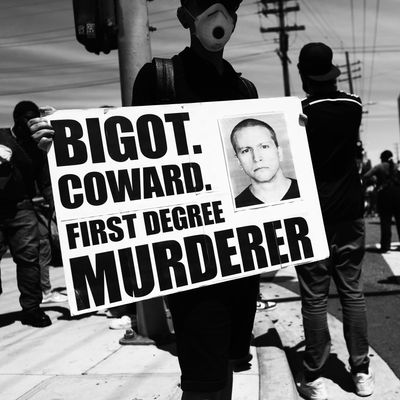
As the trial against the former police officer accused of killing George Floyd began Monday, the horrible facts of the incident were etched into many Americans’ minds. In May 2020, a video captured the last nine minutes of Floyd’s life, as he repeatedly gasped “I can’t breathe” while Derek Chauvin, a white cop, knelt on his neck. Floyd, a Black man, was arrested after allegedly using a counterfeit $20 bill to pay for cigarettes. The tragedy sparked nationwide protests in more than 150 U.S. cities and has given rise to the biggest racial-justice movement in the U.S. since the 1960s. Chauvin’s trial is the highest-profile police brutality case since 1991, when four cops were charged with excessive use of force after beating Black motorist Rodney King. Floyd’s murder came on the heels of police killings of other Black people, such as Breonna Taylor, Daniel Prude, and Rayshard Brooks, and activists want the trial to provide some long-overdue accountability for state-sanctioned racial violence. A few hundred people gathered outside the courthouse Monday evening, shouting “Say his name!” and wearing shirts with Floyd’s face. Historically, cases involving police brutality have often ended in acquittals. Here’s what you need to know about Chauvin’s trial and the likelihood of a conviction.
What are the charges?
Chauvin’s most serious charge is second-degree unintentional murder, which in this case involves killing someone by inflicting “substantial bodily harm” and can carry up to 40 years in prison. The former officer also faces a third-degree murder charge, requiring proof that he acted in an “eminently dangerous” way with disregard for human life (this is often the charge pressed against those who fire shots randomly into a crowd or drive on the wrong side of the road). It could result in a 25-year-long sentence. Second-degree manslaughter is the least serious of the charges Chauvin faces, for consciously taking risks that a reasonable person would have known could cause death.
What are the arguments on either side?
The arguments in the case will focus on two main questions: whether Chauvin’s actions significantly contributed to Floyd’s death, and whether those actions were reasonable. The prosecution is arguing that Chauvin’s actions killed Floyd by cutting off his oxygen flow, while the defense is claiming Floyd died from other causes. Though the complete autopsy report classified Floyd’s death as a homicide because Chauvin was restraining him, it also noted that Floyd had heart disease, hypertension, and a mix of fentanyl and methamphetamine in his system, both of which can cause cardiac arrest. Defense attorney Eric Nelson said he would show evidence that before the fatal incident, Floyd had taken drugs in his car in an attempt to hide the illicit substances from police. His team will point to video evidence that Floyd began to say he couldn’t breathe before being restrained.
Nelson will also argue that Chauvin’s chokehold was a justified use of self-defense in response to an intoxicated, unpredictable, and physically strong suspect. He will present evidence from a 911 caller who described Floyd as “not in control of himself” and testimony from a nearby store employee who said the man looked “under the influence.”
The prosecution, on the other hand, will heavily rely on the video capturing Floyd’s death, which attorney Jerry Blackwell showed in full during his opening statement. His team will use more testimony to help support the argument that Floyd died from oxygen deprivation rather than an opioid overdose, such as calling on an expert to say that Chauvin used “lethal force” against Floyd and on a police commander to confirm that the former officer had been trained to do CPR.
The state lawyers will at use evidence of Chauvin’s previous behavior, such as his use of a chokehold while arresting a woman in 2017, to attempt to establish a pattern of recklessness. They will make the case that Chauvin knew how to safely arrest someone by proving that medical professionals had already once explained to him, during a 2015 arrest, that an intoxicated male could die from prolonged restraint.
What’s the likelihood of a conviction?
Keith Ellison, Minnesota’s attorney general, has already said that “it’s hard to convict the police even when the criminal wrongdoing appears to be in front of your eyes.” History bears that out: In other high-profile police-brutality cases against Black people, like those of Freddie Gray and Rodney King, officers have been acquitted, and in countless others, like that of Breonna Taylor, officers have not even faced charges for the murders. (Brett Hankinson, the cop who killed Taylor, was indicted on charges that didn’t even involve her death.)
There are many facts that work in the prosecution’s favor, including the clear video evidence of what happened. (One lawyer told the Chicago Tribune that, if he were the prosecutor, he would keep a still shot of Chauvin’s expressionless face up for the jurors to see: “You want to show indifference?” said Clayton Tyler, a defense attorney. “Just look at him.”) Since there are three separate charges of varying degrees of severity, there’s a decent chance the jury will convict Chauvin of at least one. Legal experts say it seems likely that Chauvin could be found guilty of committing reckless actions that showed disregard for human life, the criteria for the third-degree murder charge. And to convict him of the most serious charge, prosecutors only need to prove that his actions were a substantial factor in Floyd’s death, rather than the sole cause of it.
On the other hand, the defense lawyers only need to convince one juror that there’s reasonable doubt as to whether Chauvin’s actions ended a life. And while Chauvin’s guilt may seem obvious from the video, he’s authorized to use force as a police officer making decisions in pressure-filled situations. As law professor Ted Sampsell-Jones points out in the Dispatch, defining whether Chauvin’s conduct was a “substantial causal factor” can veer into murky territory. “That definition is somewhat circular,” he writes, “and it raises the question: How substantial is substantial enough?”


